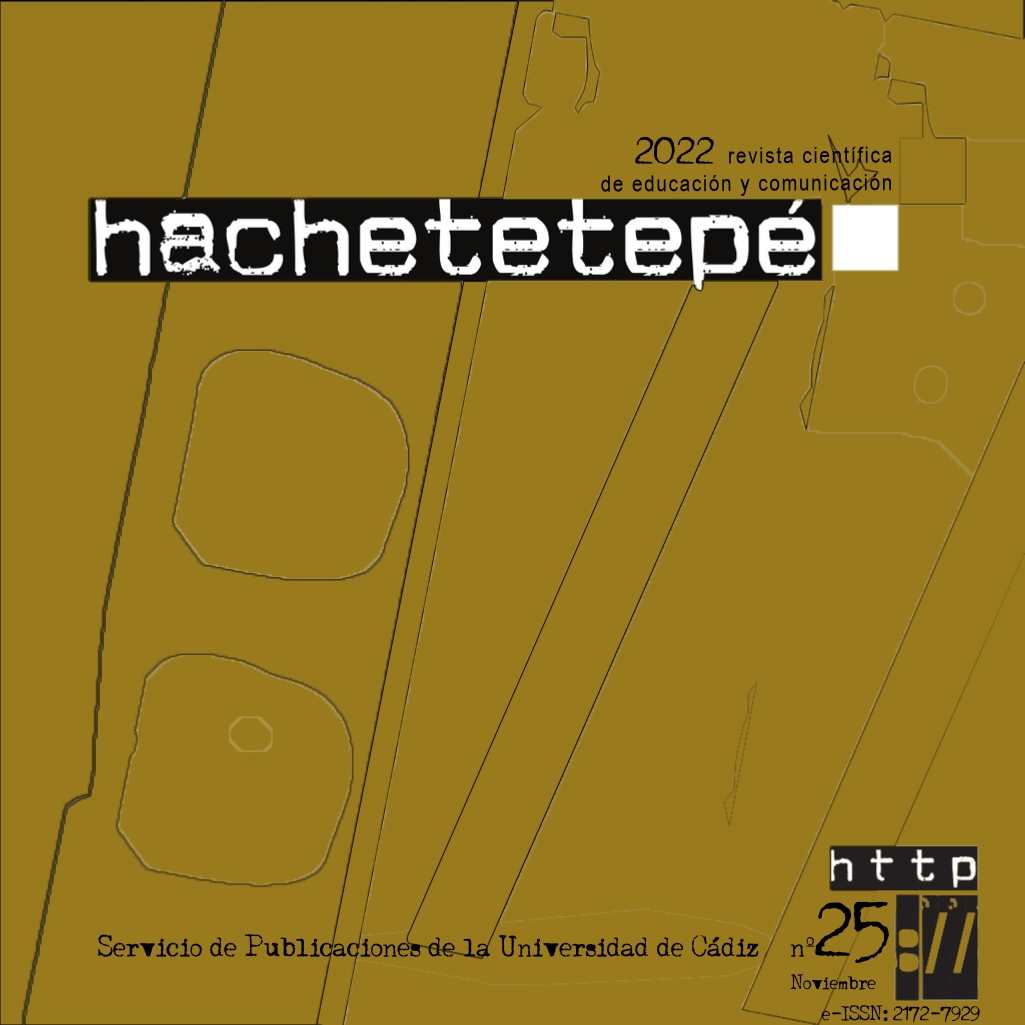Producción de recursos educativos para la enseñanza del portugués en la educación superior

Descargas
- PDF (Português (Brasil)) 200
- EPUB (Português (Brasil)) 65
- VISOR (Português (Brasil))
- MÓVIL (Português (Brasil))
- XML (Português (Brasil)) 7
DOI
https://doi.org/10.25267/Hachetetepe.2022.i25.2205Información
Resumen
Este artículo tiene como objetivo analizar tres materiales didácticos producidos para el curso en línea “Oficina de Língua Portuguesa: Leitura e Produção de Textos”, ofrecido por Faculdade de Letras de la Universidade Federal de Minas Gerais, en Brasil. En este análisis, buscamos analizar cualitativamente la elaboración de materiales frente a las especificidades de la modalidad de Educación a Distancia y la enseñanza de temas gramaticales en el contexto de la alfabetización académica. Para ello, se definieron como ejes de análisis las siguientes categorías: recursos multimodales; estrategias lingüísticas, discursivas y pedagógicas; recursos tecnológicos y conceptos gramaticales. Como resultado, se identificaron aspectos a mejorar, como el predominio del enfoque tradicional de la gramática, pero también aspectos positivos, como la diversidad en el uso de las lenguas y en las formas esperadas de leer y responder. A partir de los resultados, se propusieron algunas características que pueden contribuir a la revisión de los materiales y también a la reflexión sobre la producción de recursos educativos en el contexto de la enseñanza del portugués a distancia.
Palabras clave
Descargas
Agencias de apoyo
Cómo citar
Licencia
Derechos de autor 2022 Daniervelin Renata Marques Pereira, Thaís Fernanda Viana Batista

Esta obra está bajo una licencia internacional Creative Commons Atribución-NoComercial-SinDerivadas 4.0.
Aquellos autores/as que tengan publicaciones con esta revista, aceptan los términos siguientes:
- Conservarán sus derechos de autor y garantizarán a la revista el derecho de primera publicación de su obra, el cual estará simultáneamente sujeto a la Licencia de reconocimiento de Creative Commons. Se pueden copiar, usar, difundir, transmitir y exponer públicamente, siempre que se cite la autoría, la url, y la revista, y no se usen para fines comerciales. No se permite hacer obras derivadas.
- Podrán adoptar otros acuerdos de licencia no exclusiva de distribución de la versión de la obra publicada (p. ej.: depositarla en un archivo telemático institucional o publicarla en un volumen monográfico) siempre que se indique la publicación inicial en esta revista.
- Difundir su obra a través de Internet (p. ej.: en archivos telemáticos institucionales o en su página web) una vez que el manuscrito sea aceptado, lo cual puede producir intercambios interesantes y aumentar las citas de la obra publicada. (Véase El efecto del acceso abierto)
Hachetetepé. Revista científica de educación y comunicación no cobra honorarios ni por la presentación de manuscritos ni por la publicación de sus artículos.
Citas
Amaral, L., Pereira, D., e Coscarelli, C. (2020). Research in practice: online academic literacy for Brazilian undergraduate students. Em D. L. D. I., Rodrigez e J. Q. G., Silva (Orgs.). Práticas discursivas em letramento acadêmico. Questões em estudo V. 3. Estudos aplicados à prática da escrita acadêmica: colocando a mão na massa, (pp.21-48). Editora PUC Minas. https://bit.ly/3RtlfsB
Antunes, I. (2009). Língua, texto e ensino: outra escola possível. Parábola Editorial.
Antunes, I. (2014). Gramática contextualizada: limpando ‘o pó das ideias simples’. 1. ed. Parábola Editorial.
Arruda, E. P. (2020). Educação remota emergencial: elementos para políticas públicas na educação brasileira em tempos de Covid-19. EmRede, 7(1), 257-275. https://doi.org/10.53628/emrede.v7.1.621
Bagno, M. (2007). Nada na língua é por acaso: por uma pedagogia da variação linguística.Parábola.
Brasil (2007). Ministério da Educação. Referenciais de qualidade para educação superior a distância. https://bit.ly/3xBnRwO
Carneiro, M. L. F. e Silveira, M. S. (2014). Objetos de Aprendizagem como elementos facilitadores na Educação a Distância. Educar em Revista, Curitiba, (4), 235-260. https://doi.org/10.1590/0104-4060.38662
Corrêa, M. A.(2013). Os materiais didáticos como recursos fundamentais de potencialização da qualidade do ensino e aprendizagem na EAD. E-tech: Tecnologias para Competitividade Industrial, 6(1), 125-140. https://doi.org/10.18624/e-tech.v6i1.280
Gabardo, P., De Quevedo, S. R. P., e Ulbricht, V. R. (2010). Estudo comparativo das plataformas de ensino-aprendizagem. Encontros Bibli: revista eletrônica de biblioteconomia e ciência da informação, 65-84. https://doi.org/10.5007/1518-2924.2010v15nesp2p65
Mota, J. B. e Leonardo, E. D. S. (201-). Planejamento e produção de materiais didáticos para EAD. Ed. UFV. https://bit.ly/3RVSaWU .
Nascimento, R. G. do., Bezerra, F. A. S., e Heberle, V. M. (2011). Multiletramentos: iniciação à análise de imagens. Linguagem & Ensino, 14(2), 529-552. http://doi.org/10.15210/RLE.v14i2.15403
Rojo, R., e Moura, E. (2012). Multiletramentos na escola. Parábola.
Rosalin, B. C. M., Cruz, J. A. S. e Mattos, M. B. G. de (2017). A importância do material didático no ensino a distância. RPGE–Revista Online de Política e Gestão Educacional, 21(1), 814-830. http://doi.org/10.22633/rpge.v21.n.esp1.out.2017.10453
Significado dos Símbolos e Simbologias. Número 10. https://www.dicionariodesimbolos.com.br/numero-10/
Travaglia, L. C., Araújo, M. H. S. e Alvim, M. T. de F. (2007). Metodologia e prática de ensino de língua portuguesa. EDUFU.






